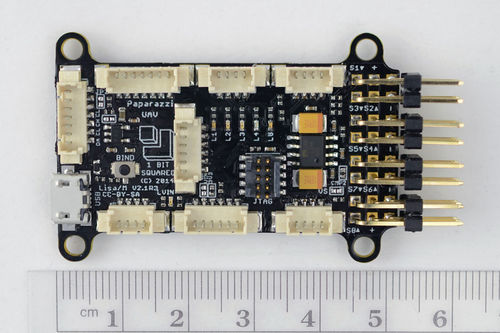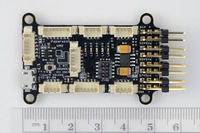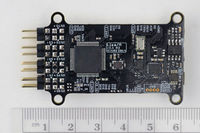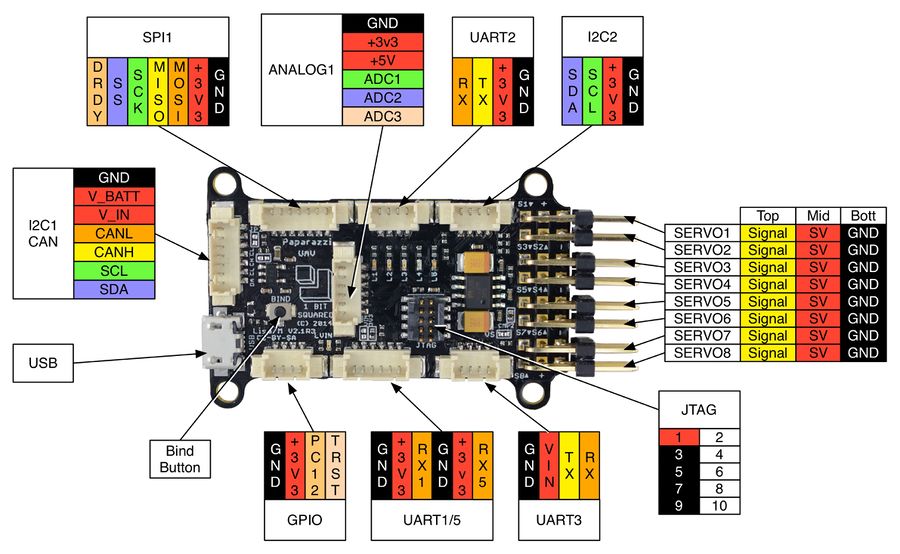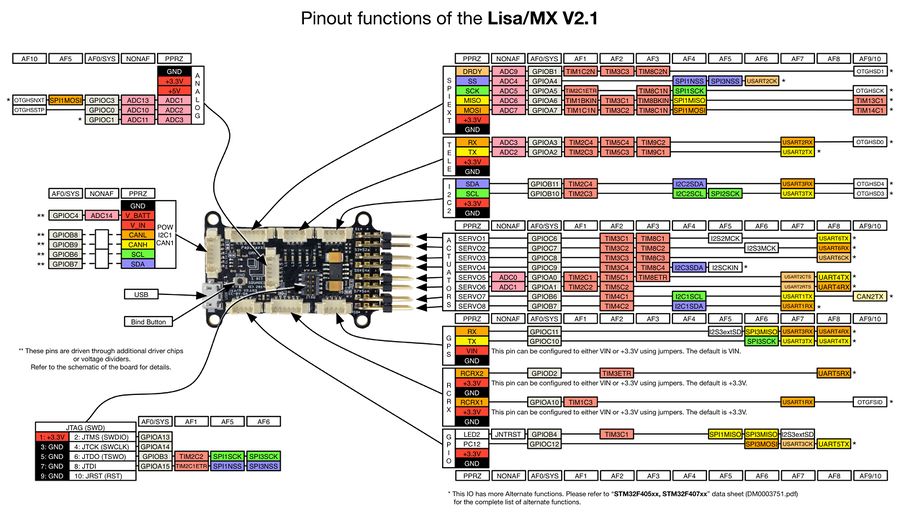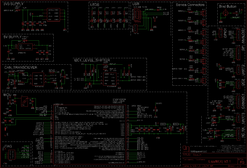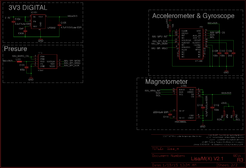Difference between revisions of "Lisa/MX"
(Created page with "Lisa/MX features a very powerful 32bit ARM Cortex M4 micro processor, and is still backwards compatible to the Lisa/M you know and love. With the improved processing power and...") |
|||
| (11 intermediate revisions by 2 users not shown) | |||
| Line 1: | Line 1: | ||
Lisa/MX features a very powerful 32bit ARM Cortex M4 micro processor, and is still backwards compatible to the Lisa/M you know and love. With the improved processing power and hardware accelerated Floating Point arithmetic the possibilities of what you can do with the platform are even greater than before. | <div style="float: right; width: 15%"><categorytree style="float:right; clear:right; margin-left:1ex; border: 1px solid gray; padding: 0.7ex;" mode=pages>Autopilots</categorytree></div> | ||
<div style="float: right; width: 45%; overflow: hidden">[[Image:LisaMX_V2_1_top.jpg |right|500px|Lisa/MX V2.1]]</div> | |||
<div style="float: right; width: 40%">__TOC__</div> | |||
Lisa/MX features a very powerful 32bit ARM Cortex M4 micro processor, and is still backwards compatible to the [[Lisa/M_v2.0|Lisa/M]] you know and love. With the improved processing power and hardware accelerated Floating Point arithmetic the possibilities of what you can do with the platform are even greater than before. | |||
The hardware was developed as part of the Paparazzi UAV framework project and is fully integrated and very well tested. | The hardware was developed as part of the Paparazzi UAV framework project and is fully integrated and very well tested. | ||
This version of the board does not support programming over the built in USB port (DFU bootloader). You will need the Black Magic Probe or compatible JTAG/SWD programmer to be able to use this board. | This version of the board does not support programming over the built in USB port (DFU bootloader). You will need the [[Debug_Probes|Black Magic Probe]] or compatible [[JTAG|JTAG/SWD programmer]] to be able to use this board. | ||
= Features = | = Features = | ||
| Line 28: | Line 32: | ||
* 8 PWM outputs/inputs for servos or legacy PPM RC receivers | * 8 PWM outputs/inputs for servos or legacy PPM RC receivers | ||
* 3 Analog inputs for thermopiles, sensors or other | * 3 Analog inputs for thermopiles, sensors or other | ||
<gallery widths=200px heights=200px> | |||
Image:LisaMX V2 1 top.jpg|Lisa/MX V2.1 top view | |||
Image:LisaMX V2 1 bottom.jpg|Lisa/MX V2.1 bottom view | |||
</gallery> | |||
= Pinout = | |||
<div style="float: right; width: 100%"> | |||
[[Image:LisaMX_V2_1_top_labeled.jpg|900px]] | |||
[[Image:LisaM_V2_1_top_labeled_verbose.jpg|900px]] | |||
</div> | |||
= Schematic = | |||
= Example Setup = | |||
= Revision Changes = | = Revision Changes = | ||
| Line 39: | Line 59: | ||
Fixed USB power bus. The STM32 will not detect phantom USB devices in high ambient temperatures. | Fixed USB power bus. The STM32 will not detect phantom USB devices in high ambient temperatures. | ||
Increased mounting hole size to the more common M3 screws. | Increased mounting hole size to the more common M3 screws. | ||
== Schematic == | |||
<gallery widths=250px heights=168px> | |||
Image:Lisa_m_v2_1_r3_sheet_1.png | Lisa/MX V2.1 R3 Schematic Sheet 1/2 | |||
Image:Lisa_m_v2_1_r3_sheet_2.png | Lisa/MX V2.1 R3 Schematic Sheet 1/2 | |||
</gallery> | |||
<br style="clear:both"> | |||
= Where to Buy = | = Where to Buy = | ||
[http://1bitsquared.com/products/lisa-mx-autopilot Lisa/MX V2.1] is available for purchase | [http://1bitsquared.com/products/lisa-mx-autopilot Lisa/MX V2.1] is available for purchase in the [http://1bitsquared.com 1BitSquared] store. | ||
= Troubleshooting Checklist = | |||
== Problem, it does not flash over USB == | |||
* If you have a stock Lisa/MX it will not have a DFU boot loader, USB flashing is not supported by default | |||
* If you flashed luftboot bootloader on the board all following apply to Lisa/M as well as Lisa/MX | |||
* Connect the USB cable to the computer. Does the power LED light up? | |||
* Connect the USB cable, what does "dmesg" indicate before and after plugging in the cable? Do you see an indication that the linux kernel finds a USB device? | |||
* Check what "lsusb" is printing out. Do you see the device in there? | |||
* Test with a different USB cable. It is a known issue that some USB cables work and others don't. Find a better quality shorter USB cable and try again. | |||
* If it is there and it still is not flashing. Did you install the paparazzi udev rules? | |||
* Did you try flashing as root and it worked? Then your permissions are wrong, go back and install the udev rules again. | |||
* All fails use Black Magic Probe. It is the recommended way of programming the Lisa autopilots. If you have one do not use the USB boot loader. | |||
== Problem, it does not flash over Black Magic Probe == | |||
* What does "dmesg" say? | |||
* Is the black magic probe enumerating correctly as ttyACM0 and ttyACM1? | |||
* Check your USB cable. Some USB cables are "bad". | |||
* Check what "lsusb" says. | |||
* Make sure you have permissions to access the tty devices. On many linux distributions the device is owned by "dialout" group. You can check what group you are in by typing "id" in the console. If you are not part of that group you should add yourself. Read some tutorials about Linux permission system if you don't know how it works. | |||
* Make sure you have the paparazzi udev rules installed. They create a node that makes the enumaration easier. See appropriate paparazzi documentation. [[Installation]] | |||
[[Category:Hardware]] [[Category:Autopilots]] | [[Category:Hardware]] [[Category:Autopilots]] | ||
Latest revision as of 08:36, 29 August 2016
Lisa/MX features a very powerful 32bit ARM Cortex M4 micro processor, and is still backwards compatible to the Lisa/M you know and love. With the improved processing power and hardware accelerated Floating Point arithmetic the possibilities of what you can do with the platform are even greater than before.
The hardware was developed as part of the Paparazzi UAV framework project and is fully integrated and very well tested.
This version of the board does not support programming over the built in USB port (DFU bootloader). You will need the Black Magic Probe or compatible JTAG/SWD programmer to be able to use this board.
Features
This board provides the following features:
- STM32F4 168MHz ARM Cortex-M4 microcontroller with FPU
- 1 Mbyte of Flash memory
- 192+4 Kbytes of SRAM including 64-Kbyte of CCM (core coupled memory) data RAM
- Cryptographic acceleration: hardware acceleration for AES 128, 192, 256, Triple DES, HASH (MD5, SHA-1), and HMAC
- True random number generator
- 3 axis gyroscope (connected over SPI for high speed sampling and low latency)
- 3 axis accelerometer (connected over SPI for high speed sampling and low latency)
- 3 axis magnetometer
- barometer
- I2C 5V level shifter for compatibility with 5V I2C ESCs
- CAN (Control Area Network) transceiver
- 2 TTL level serial ports for telemetry radio and GPS
- 1 high speed SPI interface for high speed hardware expansion
- 2 I2C interfaces for actuators and sensors
- 2 serial input interfaces for remote control receivers
- 1 CAN interface for actuators and sensors
- 1 USB port
- 8 PWM outputs/inputs for servos or legacy PPM RC receivers
- 3 Analog inputs for thermopiles, sensors or other
Pinout
Schematic
Example Setup
Revision Changes
The newest Version 2.1 Revision 3 of the Lisa/MX autopilot. It has been improved from the predecessor V2.0 version of the board.
Removed BMP pressure sensor that has not been used for quite some time. Removed Analog 2 connector that was connected in parallel with the LEDs. Integrated Aspirin IMU into the board to save weight and production cost as well as increase reliability. Added "Bind button". No need for custom jumper wires any more when you want to bind your transmitter. Fixed USB power bus. The STM32 will not detect phantom USB devices in high ambient temperatures. Increased mounting hole size to the more common M3 screws.
Schematic
Where to Buy
Lisa/MX V2.1 is available for purchase in the 1BitSquared store.
Troubleshooting Checklist
Problem, it does not flash over USB
- If you have a stock Lisa/MX it will not have a DFU boot loader, USB flashing is not supported by default
- If you flashed luftboot bootloader on the board all following apply to Lisa/M as well as Lisa/MX
- Connect the USB cable to the computer. Does the power LED light up?
- Connect the USB cable, what does "dmesg" indicate before and after plugging in the cable? Do you see an indication that the linux kernel finds a USB device?
- Check what "lsusb" is printing out. Do you see the device in there?
- Test with a different USB cable. It is a known issue that some USB cables work and others don't. Find a better quality shorter USB cable and try again.
- If it is there and it still is not flashing. Did you install the paparazzi udev rules?
- Did you try flashing as root and it worked? Then your permissions are wrong, go back and install the udev rules again.
- All fails use Black Magic Probe. It is the recommended way of programming the Lisa autopilots. If you have one do not use the USB boot loader.
Problem, it does not flash over Black Magic Probe
- What does "dmesg" say?
- Is the black magic probe enumerating correctly as ttyACM0 and ttyACM1?
- Check your USB cable. Some USB cables are "bad".
- Check what "lsusb" says.
- Make sure you have permissions to access the tty devices. On many linux distributions the device is owned by "dialout" group. You can check what group you are in by typing "id" in the console. If you are not part of that group you should add yourself. Read some tutorials about Linux permission system if you don't know how it works.
- Make sure you have the paparazzi udev rules installed. They create a node that makes the enumaration easier. See appropriate paparazzi documentation. Installation
